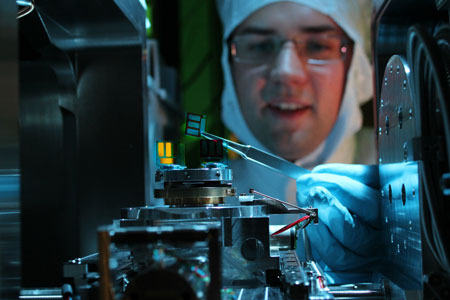| Oct 07, 2011 |
Doping for solar cells - New technique optimizes the generation of charge carriers
|
|
(Nanowerk News) In organic solar cells, organic molecules are used to convert light into electric energy. Providing a renewable source of energy, organic solar cells are a promising eco-friendly future technology. However, their efficiency is still far below that of conventional solar cells made of anorganic semiconductors. The team of Dr. Enrico da Como and Prof. Jochen Feldmann, LMU chair of photonics and optoelectronics, has been successful in optimizing the electronic properties of organic semiconductors substantially ("Reduced Charge Transfer Exciton Recombination in Organic Semiconductor Heterojunctions by Molecular Doping").
|
 |
|
Organic solarcells basically consist of two components: in most cases a polymer, that releases electrons upon light incidence and a fullerene, that accepts the electrons. Thus an electric current is generated. Da Como and Feldmann, both being PIs of the cluster of excellence "Nanosystems Initiative Munich" (NIM), investigated this charge transfer and gained insight into the dynamics of the physical process: "In order to enhance the efficiency of organic solar cells, the charge transfer at the interface between the polymer and the fullerene has to be understood and optimized," explains Da Como.
|
|
During the charge transfer, normally an intermediate state, called exciplex, occurs. In this state, the charge is distributed over neighboring molecules. Using a unique combination of spectroscopic methods, the scientists were able to explore this state, which reduces the efficiency of energy conversion. "We could show, that the implementation of additional molecules into the polymer - so called doping - reduces the generation of exciplex states and enhances the separation of charge carriers," says Da Como.
|
|
This new concept for the charge transfer in organic semiconductors could be pathbreaking for the efficiency enhancement of organic solar cells. The scientists have already produced prototypes of organic solar cells with the new concept, in order to test the practical experience and to investigate how the doping affects the morphology and conductance.
|
|
The project has been funded by the Deutsche Forschungsgemeinschaft (DFG) within the Schwerpunktprogramm 1355 (Elementarprozesse der Organischen Photovoltaik).
|

